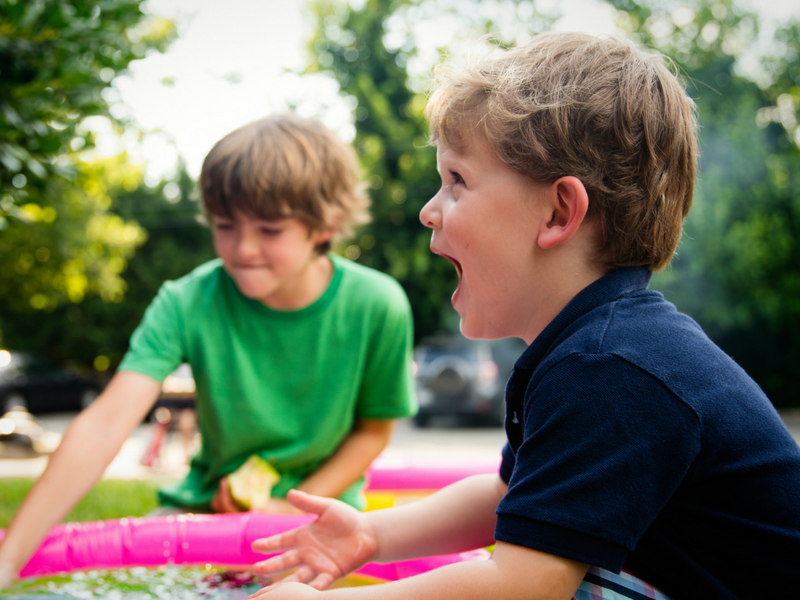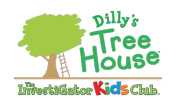
02 May 6 Summer Activities for Preschoolers and What Your Child Can Learn from Them
Whoever made up the phrase “all work and no play” clearly wasn’t referring to how children learn. In fact, when it comes to childhood development, play and work go hand in hand. Too often we focus on one or the other—we look for a fun activity to do with our child (play) or we look for a learning activity (work). But children benefit most when we combine these efforts. We’ve done the legwork and chosen 6 summer activities for preschoolers that are inexpensive, kid-friendly, and have a host of learning opportunities to keep your child smiling and learning all summer long. Enjoy!
Make the most of summer fun by turning these summer activities for preschoolers into learning opportunities.
-
Tin Foil River
Materials: Tin foil (aluminum foil), water
Head outside with a roll of tin foil and make a river. Roll the tin foil out and bend it up along the sides. Make the sides as high as you like and make the river as long as you like. Then place the tin foil riverbank along a slope on the ground. Have your child pour water and watch it flow down over the tin foil. Children will love chasing the water down the river and drenching themselves along the way!
Teachable moments
- Science! Make this activity a learning opportunity by collecting data! Time how long it takes the water to complete its course through the tin foil. Write down the time. Take it even further by changing a variable. Put a few bends in the river, make the sides higher or lower, then time it again.
- Social Studies! Look up local rivers on a map. Notice where they start and where they end. Make a few different tin foil rivers and name them after rivers in your area!
-
Pool Noodle Race Track?
Materials: Pool Noodle, knife, toy cars
Grab a pool noodle and cut it lengthwise to make two race tracks. Then lay the tracks out across different types of terrain and race two cars across the tracks. Encourage children to try different lengths of track and different types of terrain!
Teachable moments
- Math! Use the stopwatch on your phone to time how long it takes the car to complete the track. Use the words “more than” and “less than” as you talk about the different times. “This car took 3 more seconds than this car.” The concept of “more than” and “less than” is how your child’s Kindergarten teacher will likely introduce addition and subtraction.
- Reading/Language Arts! Have your child make up a story about who is driving the car and why they are there. Keep asking questions until the story has a clear character, a setting, and a beginning, middle, and end. These are the elements of a story they’ll need to know in Kindergarten.
-
Backyard Waterfall
Materials: plastic cups and bottles, knife, hammer and nails, fence or other “wall” for your waterfall.
Gather a variety of plastic cups and bottles. Cut an opening on the side of the bottles and cups so that water can pass through them. Use the hammer and nails to affix the bottles and cups against a fence wall, arranging them so they tilt from one vessel to the next. Pour water into the top vessel and watch it flow down to the bottom one. Kids will of course love getting wet, but they’ll also enjoy trouble-shooting how to arrange the vessels for just the right flow!
Teachable moments
- Math! Count the number of cups and bottles you use. Then talk through all the different ways to make that number. For example, if you have 5 vessels, explore all the ways to make 5 (0 and 5, 1 and 4, 2 and 3). Having a strong sense of a number’s parts and whole is a critical component of Kindergarten math and a solid foundation for math skills to come.
- Science! Introduce the concept of gravity. Ask your child why the water is flowing from one cup to the next. Introduce the phrase, “What goes up, must come down” as an explanation. Explain that the same force that pulls the water down also keeps us from floating up into the atmosphere! Abstract concepts such as gravity are much easier for young children to understand when they are provided with concrete examples.
-
Shaving Cream Paint
Materials: Shaving cream, food coloring, paper bowls, spoons for mixing
Kids love any activity that ends with them getting hosed off, so this summer activity for preschoolers is sure to be a hit! Bring shaving cream, bottles of food coloring, paper bowls, and spoons for mixing out to the driveway, and prepare to get messy. Ask your child what color they would like to make the shaving cream and have them experiment as needed to get the color they desire. Then let them loose to decorate the driveway and each other with shaving cream paint.
Teachable moments
- Reading/Language Arts! Have your child write his name with the shaving cream paint. Then have him write the first letter of each family member’s name. He is focusing on himself and his family, but he is also building his alphabet knowledge. The sooner your child knows the letters of the alphabet, the sooner he can start to sound out words.
- Math! While making colors, be sure to count the number of food coloring drops used. Create number stories by narrating the process. “We used 4 drops of blue and 2 drops of yellow. That’s a total of 6 drops.” Talking about numbers in a story helps children learn the relationship between numbers in a concrete, more understandable way.
-
Eye Spy Walk
Materials: Piece of paper, crayons or markers, walking shoes
First, decide if you want to do a neighborhood walk or a nature walk. Then create a document with images of things you want your child to find on a walk. For a neighborhood walk, you might choose things like a sign, a sidewalk, a mailbox, a house, a pet, a garden, a bicycle, and a car. For a nature walk, you might choose things like a leaf, a stick, an insect, a rock, water, a tree, a flower, and a bird. Draw the images on the paper (or print them from the computer) and invite your child on an eye-spy walk. See how long it takes to find everything on your list!
Teachable moments
- Science! As you walk, tell your child that you are thinking and acting like a scientist. Explain that scientists use their senses to observe the world around them. A keen sense of observation will serve your child well in Kindergarten and beyond.
- Social Studies! Discuss the relationship of a neighborhood to a town or city, a state, to a country, a continent, and our world. Follow up the discussion with a map or globe to help your child visualize the concept. Children naturally yearn to understand their place in the world. Nurturing this will help them as they learn basic concepts of civics and government even in the early grades.
-
Washi Tape Characters
Materials: Variety of colors and patterns of washi tape, large surface area that washi tape will stick to
For this summer activity for preschoolers, let the vibrant colors and patterns of washi tape inspire you and your child to be wildly creative! Pretend you are visiting Washi-world. What would the people look like? Ask, what shape would their heads be? If you child answers, “triangle,” use the washi tape to create a triangle head. Keep asking questions and brainstorming together until you have several multi-colored characters to fill your space.
Teachable moments
- Reading/Language Arts! Go beyond how each colorful character looks and imagine a personality for each character. Go even further and develop a story line for how all these characters might interact with one another. Where would they go? What problems might they face? How would they resolve them? Discussing stories is a great way to prepare young children to comprehend what they read when they start school.
- Math! Talk about the different shapes that are in your creation. Count the triangles. Compare the sizes of different rectangles. A strong understanding of shapes is the foundation of engineering and geometry concepts that begin as early as Kindergarten.
Summer is a special time in every childhood. Enjoy these fun and playful summer activities for preschoolers and don’t miss out on what rich learning experiences they can be as well! Combing learning with play is the best way to ensure your child develops a thirst for learning that will last a lifetime!

Sorry, the comment form is closed at this time.